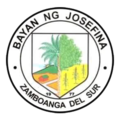This article needs additional citations for verification .(July 2014) |
Josefina Gumahan | |
|---|---|
| Municipality of Josefina | |
 Map of Zamboanga del Sur with Josefina highlighted | |
Location within the Philippines | |
| Coordinates: 8°12′52″N123°32′38″E / 8.2144°N 123.5439°E | |
| Country | Philippines |
| Region | Zamboanga Peninsula |
| Province | Zamboanga del Sur |
| District | 1st district |
| Founded | November 11, 1977 |
| Named after | Josefina Herrera Cerilles |
| Barangays | 14 (see Barangays) |
| Government | |
| • Type | Sangguniang Bayan |
| • Mayor | Catalino A. Adapon |
| • Vice Mayor | Alberto M. Etulle |
| • Representative | Divina Grace C. Yu |
| • Municipal Council | Members |
| • Electorate | 7,971 voters (2025) |
| Area | |
• Total | 56.35 km2 (21.76 sq mi) |
| Elevation | 645 m (2,116 ft) |
| Highest elevation | 1,434 m (4,705 ft) |
| Lowest elevation | 288 m (945 ft) |
| Population (2024 census) [3] | |
• Total | 11,190 |
| • Density | 200/km2 (510/sq mi) |
| • Households | 2,986 |
| Economy | |
| • Income class | 5th municipal income class |
| • Poverty incidence | 28.92 |
| • Revenue | ₱ 106.6 million (2022) |
| • Assets | ₱ 356.3 million (2022) |
| • Expenditure | ₱ 88.83 million (2022) |
| • Liabilities | ₱ 63.08 million (2022) |
| Service provider | |
| • Electricity | Zamboanga del Sur 1 Electric Cooperative (ZAMSURECO 1) |
| Time zone | UTC+8 (PST) |
| ZIP code | 7027 |
| PSGC | |
| IDD : area code | +63 (0)62 |
| Native languages | Subanon Cebuano Chavacano Tagalog |
| Website | www |
Josefina, officially the Municipality of Josefina (Cebuano : Lungsod sa Josefina; Subanen: Benwa Josefina; Chavacano: Municipalidad de Josefina; Tagalog : Bayan ng Josefina), is a municipality in the province of Zamboanga del Sur, Philippines. According to the 2020 census, it has a population of 12,205 people, making it the least populated municipality in the province. [5]



